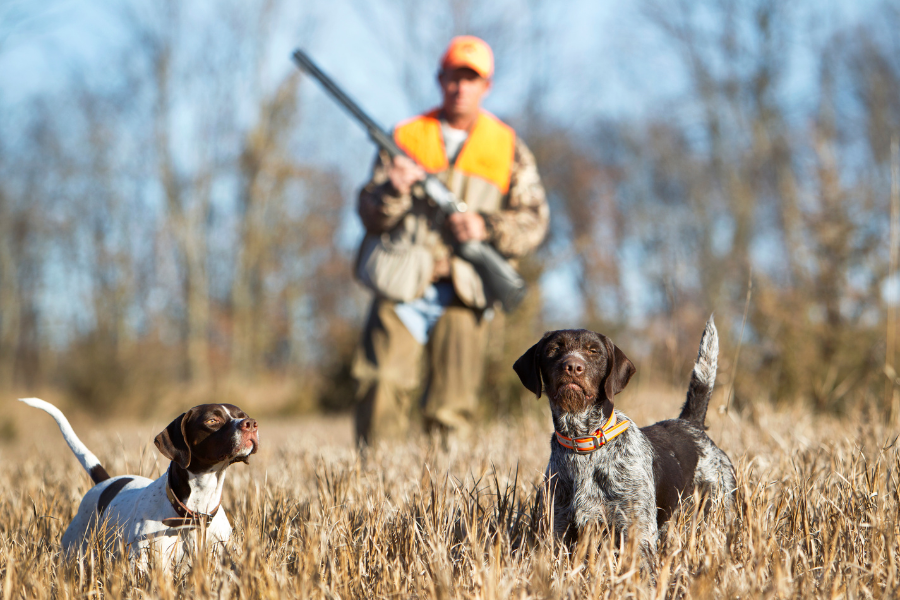So, you are a hunter and you just got a new pup (or ya got a pup that is not new) and you want to train them to come with you and assist you on your hunting adventures. Where do you start? Well, in this blog we are going to dive in to all things related to training a hunting dog. Training a dog to accompany you on a hunt is deeper than just teaching them basic commands - you are forging a bond between you and your furry friend that relies on trust and respect, and hopefully will include a whole lot of fun too.
The Bond Begins: Choosing the Right Dog
First off, just like every person is not built to play a sport like basketball or football, not every dog is wired for hunting. Some dogs have been bred for hunting, and are predisposed to have the instincts, temperament and reflexes needed for hunting. Other dogs, well, just don't. Your dog may prefer to lounge next to you on the couch all day, and that is okay! Ain't no shame in that.
So, it is important to determine if your dog is either bred for hunting, like a Labrador, a Pointer, a Setter, or a Beagle (this is not the full list), or has a temperament (eager but attuned) that will be well-suited for hunting.
Puppy Love: Starting Early
The answer to "when is a good time to start training my pooch?" is simple: the earlier the better! When you start early you have a chance to imprint and instill the habits you want your dog to have, which, over time will become ingrained and automatic. Young dogs, like young children, absorb new information at a faster rate than when they are older.
Basic Obedience: The Foundation of Training
Before you get in above your head and start working on hunting-specific training and commands, you should build a solid foundation of the basics of dog training...
Sit, Stay, and Come
These three commands are the holy trinity of dog obedience. Use positive reinforcement methods—treats, praise, and lots of belly rubs—to get your pup responding reliably to these commands.
Heel
Teaching your dog to walk at your side without pulling on the leash is crucial. You’ll need them to stay close during hunts, and this command sets the stage for that.
Introduction to Gunfire
Getting into the nitty gritty here! And this can be a challenging one, so we need to approach this tactfully, as the sound of gunfire can be scary for many dogs (and humans, for that matter).
Start Small
It is a good idea to begin with gentler noises and eventually work up in volume before you get to full gunfire. When your dog remains calm with softer noises (like hand clapping) be sure to immediately reward them - with treats, telling them they are a good boy or girl, or belly rubs (whichever your dog responds the best to).
Positive Associations
Make gunfire a positive experience by associating it with rewards. For example, fire a shot and then immediately give your dog their favorite treat. Over time, they’ll start to associate the sound with something positive.
Field Training: Putting Skills to the Test
Now that your dog is comfortable with obedience commands and the sound of gunfire, it’s time to take things to the next level: field training.
Introducing Game
Start by exposing your dog to the scent of game. You can use training dummies or scent trails to get them accustomed to the smells they’ll encounter in the field. Encourage them to follow the scent and reward them when they do.
Retrieving
Retrieving is a key skill for hunting dogs. Use a training dummy to teach your dog to retrieve game. Start with short distances and gradually increase the distance as they get better. Always use positive reinforcement to encourage them.
Advanced Commands: Fine-Tuning Skills
Once your dog has the basics down, you can move on to more advanced commands that will make them a top-notch hunting companion.
Marking
“Mark” is a command that tells your dog to pay attention to where the game falls so they can retrieve it. Use a training dummy and throw it while saying “mark.” Your dog should watch where it lands and then go retrieve it.
Blind Retrieves
A blind retrieve involves sending your dog to fetch something they didn’t see fall. Use directional commands like “left,” “right,” and “back” to guide them. Practice in a controlled environment before taking it to the field.
The Hunt: Putting It All Together
We have covered the basics - now it is time for the fun part...putting all these skills together. Only when you are fully confident that your dog is ready, you can take 'em on their first hunt! And this is where all the repetitions and hard work pay off.
Stay Calm and Patient
Your dog will likely be excited and maybe a little nervous. Stay calm and patient, offering plenty of praise and encouragement. Remember, this is a new experience for them, and they’ll look to you for cues.
Work as a Team
Hunting with a dog is all about teamwork. Trust your dog’s instincts and let them do what they’ve been trained to do. Over time, you’ll develop a rhythm and a bond that makes hunting together a joyous experience.
Maintaining Skills: Practice Makes Perfect
Training doesn’t end after the first successful hunt. Regular practice is essential to keep your dog’s skills sharp. Make training sessions fun and varied to keep your dog engaged and excited.
Regular Drills
Set aside time each week for training drills. Mix up the activities to keep things interesting. Practice obedience commands, retrieving, and scent work to maintain a well-rounded skill set.
Continued Exposure
Keep exposing your dog to different environments and scenarios. The more varied their experiences, the better they’ll perform in the field.
Conclusion: The Joy of a Well-Trained Hunting Dog
Training a dog can no doubt be challenging, and at times frustrating. But as with anything worthy of attaining, the hours of hard work is worth it. Perseverance and patience is key to make it through those challenging and trying moments, and you will (hopefully) emerge on the other side with a huge sense of accomplishment and, most importantly, a well-trained hunting dog that will be at your side for all your hunting adventures.
FAQ
What Is the Easiest to Train Hunting Dog?
While there is no definitive "easiest to train hunting dog", there are several breeds that are hard to look past, including the Labrador Retriever. They are not only the gold standard in terms of loyalty, but they are also known for their gentle nature, eager-to-please temperament, and an astute intelligence, Labs are not only quick learners but also retain their training exceptionally well. Their robust, strong build makes them ideal for enduring the physical demands of hunting, while their keen sense of smell and strong retrieving instincts ensure they excel in the field. Moreover, Labradors are incredibly versatile, capable of adapting to a diverse range of hunting scenarios, from waterfowl retrievals to more rugged upland game hunting. Their affable nature and boundless enthusiasm make the training process feel like a shared adventure rather than a chore, solidifying a bond that is both endearing and effective in the hunt.
What Is the Best Age to Train a Hunting Dog?
We touched on this earlier, but the short answer is the younger the better for training of any sort! If you are able to start your pup with some basic training (i.e. non-hunting commands) at 7-9 weeks old, that is ideal. At a young age a puppy's mind is impressionable and good habits can become ingrained. Building a solid foundation at a young age will set the stage for a seamless progression to hunt-specific commands, which you can begin at about 4-6 months old.
Are Hunting Dogs Hard to Train?
This is a loaded question (pun intended). Training a hunting dog is something that is not for every dog owner, and certainly not for every dog. If you go into it with the right mindset, that it will take time and a whole lot of repetitions, then it can be something that you view as not an immensely difficult task. If you have a hunting breed that has all of the attributes needed to be a great hunting side kick, you have an upper hand and that can make things a whole heck of a lot easier!
References
1) Vieira de Castro AC, Araújo Â, Fonseca A, Olsson IAS. Improving dog training methods: Efficacy and efficiency of reward and mixed training methods. PLoS One. 2021 Feb 19;16(2):e0247321. doi: 10.1371/journal.pone.0247321. PMID: 33606822; PMCID: PMC7895348.



